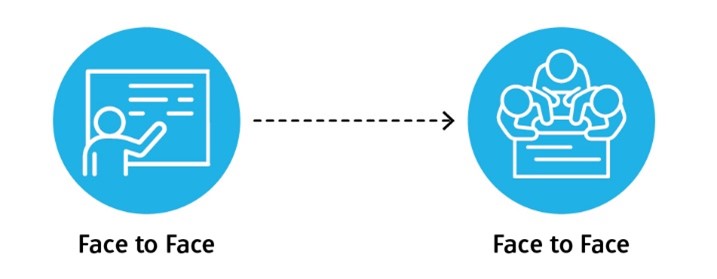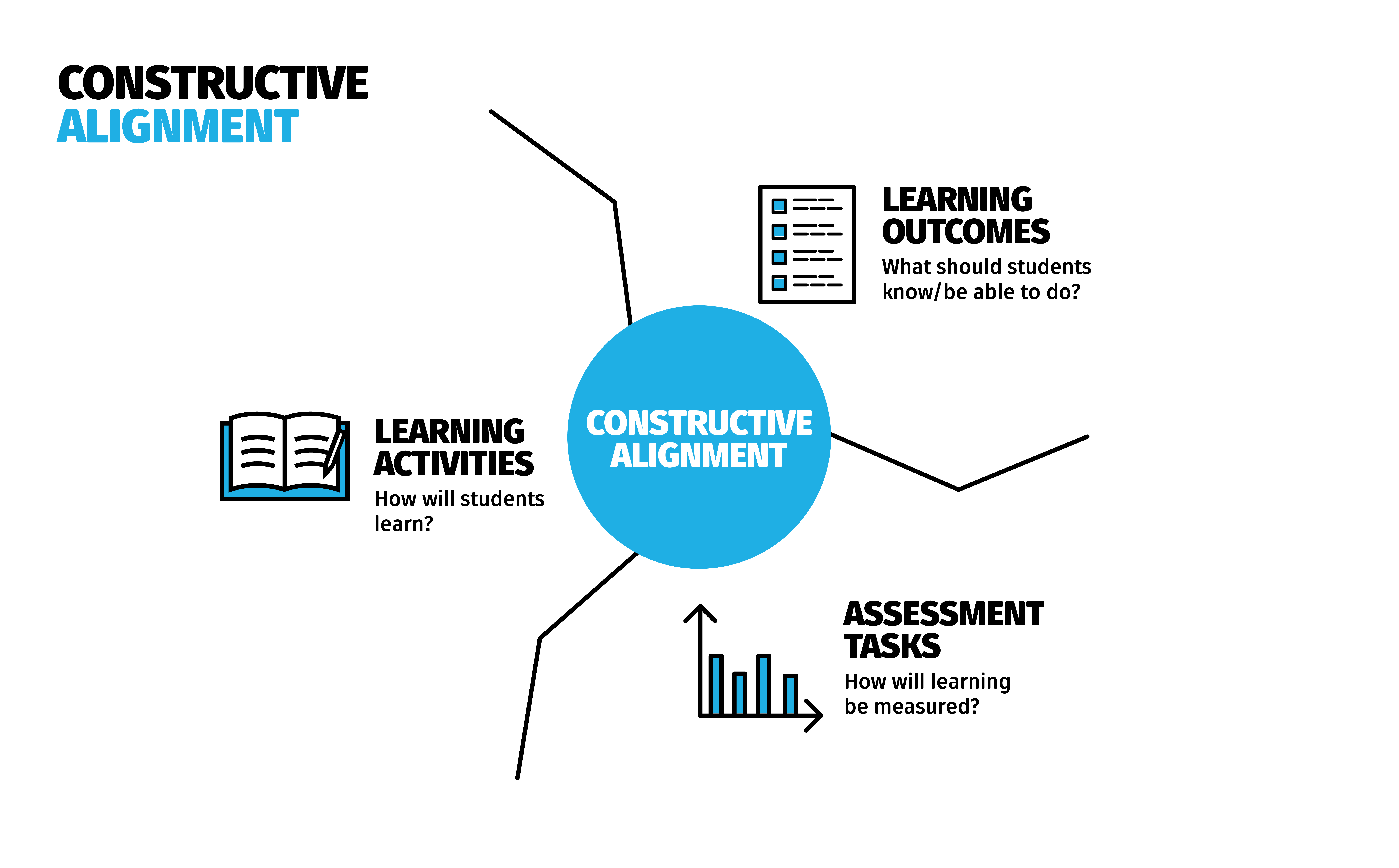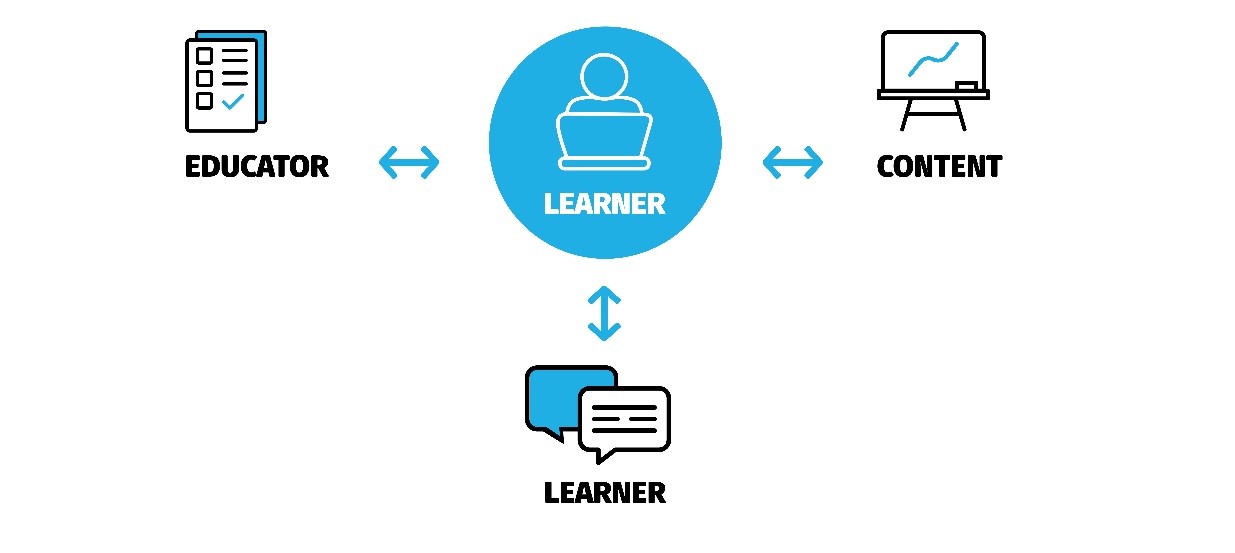
Teaching and research
COURSE DELIVERY MODE
On Campus Face To Face
 | |
CONTENT DELIVERYStudents attend on campus | ACTIVE LEARNINGStudents attend on campus labs, |
Our Face to Face course delivery mode is most closely aligned with the “traditional” concept of higher education course delivery. Students will attend a weekly set of timetabled in person activities. These will usually include a session focused on educator-led content delivery (e.g. lecture) and a session(s) focused on application and active learning (e.g. laboratories, tutorials, workshops etc). All sessions in a Face to face course will typically be educator-led, with students able to supplement these sessions via pre and post class activities completed in Canvas.
| Description | In Person Attendance (Physical space required) | Timetabled Component | |
|---|---|---|---|
Content Delivery
| Content is delivered on campus through lectures/ lectorials. Supplementary information available via LMS |
|
|
Active Learning | Students attend timetabled in person sessions (e.g. tuturials, labs, workshops) that focus on application of knowledge and concepts |
|
|
One of the most obvious benefits of Face to Face delivery is familiarity. The more traditional method of delivering face to face content via in-person lectures and supplementing this with in-person smaller group sessions (e.g. tutorials, labs, etc) is familiar to most students and staff. Regular in person timetabled sessions provides a level of structure which can be beneficial to some students.
This delivery mode also provides a great opportunity to develop relationships between staff, students, and peers by virtue of educators and learners being in the same place and the same time.
In-person lectures do afford educators some “real time” flexibility. The pacing, content, and delivery style for lectures and tutorials can be amended “on the fly” in response to what students need on the day. This includes opportunities for educators to provide immediate informal feedback during the sessions.
The familiarity and structure of Face to Face delivery is somewhat offset by the lack of flexibility available to students studying courses delivered in this mode. With many of our students experiencing increases in work, life and family commitments that compete for their time, it is becoming more challenging for them to commit to long periods of time on campus each week.
When the same course is delivered Face to Face across multiple locations, this mode can result in duplication of effort for potentially little value. The need to present the same lecture multiple times at different locations can be time consuming and raises the possibility of different experiences for students at different locations. Consistency and efficiencies can be gained by presenting content online to the multiple cohorts and focusing educators efforts of the smaller group sessions at different locations.
Face to Face delivery also obviously requires physical spaces to be accessible and timetabled.
Regardless of the mode of delivery, ensuring constructive alignment should be a primary focus of any course design work. Constructive alignment is a design approach that ensures alignment between learning outcomes, teaching methods, and assessments, fostering meaningful learning by connecting these elements in a coherent and purposeful way.

What should you consider when designing a course for Face to Face delivery?
- Active Learning Opportunities: Ensure that the subject design incorporates active learning strategies that encourage students to actively engage with the course content during in-person sessions. This could include group discussions, problem-solving activities, case studies, hands-on experiments, or simulations.
- Student Engagement in Lectures: Lectures do not need to be limited to passive transmission of information from educator to student. Consider incorporating opportunities for students to engage in the lecture. This may be through activities such as polling activities or informal Q&A. Using a variety of instructional methods in the classroom can maintain student interest and cater to different learning styles and preferences.
- Clear Learning Outcomes: Clearly express what your students should be able to achieve by the end of each week, how the teaching and learning activities will contribute to these outcomes, and how weekly learning outcomes align with and contribute to the overall course learning outcomes.
- Utilise Technology: Make effective use of the available educational technologies. This applies both to the Canvas site, but also opportunities to incorporate educational technologies in Face to Face teaching.
- Engaging Course Materials: Use a variety of course materials that are engaging and interactive. This can include multimedia resources, visual aids, handouts, or online quizzes to enhance students' understanding and retention of the subject matter. Consider using existing resources from a range of sources, rather than focusing on creating all resources from scratch.
- Collaborative Learning: Encourage collaborative learning experiences by incorporating group activities and projects that require students to work together. This fosters teamwork, communication skills, and deeper understanding through peer interaction.
- Reflection and Evaluation: Incorporate opportunities for students to reflect on their learning experiences and evaluate their progress. Encourage self-assessment, peer feedback, and facilitate class discussions. Also consciously plan to reflect on your own teaching practices throughout the semester.
Learning Design and Teaching Innovation can assist using our Course Design Toolkit.
Regardless of the mode of delivery, all University of Newcastle courses include a Canvas course site, and each site should be developed with consideration of the University’s Course Site Quality Principles.
Even in a Face to Face course, the site is likely to be your students’ first interaction with the course (prior to attendance at any scheduled face to face sessions) and it is vital that the site is used to create a positive first impression.
When structuring your Canvas site, consider the following:
- Course Introduction: A well thought out, welcoming, clear and structured introduction in the course site can go a long way to ensuring that your expectations of learners are well understood. It can also help minimise the time needed to address administrative questions during the first few weeks of term.
- Clear Navigation and Organisation: Ensure that the Canvas site is well-organized. Use a logical modular structure that is intuitive for students to navigate. Use simple statements to outline your expectations of students for each week/module. Do your students know what they need to do this week?
- Incorporate Pre-Class Activities: Use the Canvas site to provide pre-class resources that can help students prepare for in-person sessions. This could include pre-reading materials, videos, quizzes, or discussion prompts that introduce key concepts or stimulate thinking prior to face-to-face interactions. Explain how these activities contribute to the weekly learning outcomes.
- Incorporate Post-Class Activities: Incorporate post-class activities on the Canvas site to reinforce and extend learning beyond the in-person sessions. These activities could include reflection exercises, online discussions, follow-up readings, or additional assignments that encourage students to apply and consolidate their learning.
- Discussion boards, announcements, and reminders. Clearly articulate how you will utilise Canvas communication channels within your course and use these consistently. Encourage students to participate in these discussions by posing thoughtful questions, sharing relevant resources, or providing prompts for reflection and peer interaction.
Digital Content Accessibility: Ensure that all digital content provided through Canvas is accessible to all students. Consider providing alternative formats for text-based content, such as transcripts for videos or audio recordings, and ensure that the learning materials meet accessibility guidelines.
Interactive learning activities promote active learning and engagement through three types of interaction: learner-content, learner-educator, and learner-learner. That is, your students should be given opportunities to explore a concept from different angles.
FACE TO FACE
Learner-Educator |
|
Learner-Learner |
|
Learner-Content |
|
The University of Newcastle acknowledges the traditional custodians of the lands within our footprint areas: Awabakal, Darkinjung, Biripai, Worimi, Wonnarua, and Eora Nations. We also pay respect to the wisdom of our Elders past and present.